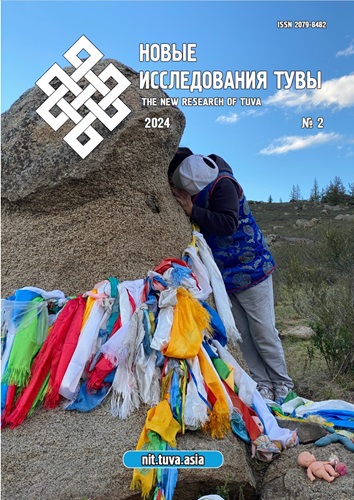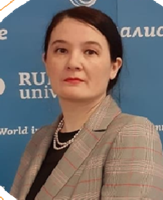The River in Tuvan paremics: imagery and symbolism (against the background of the Central Asian paremiological continuum)
DOI:
https://doi.org/10.25178/nit.2024.2.9Keywords:
paremic; proverb; linguistic culture; Tuvan language; Tuvan folklore; natural landscape code of culture; riverAbstract
The article analyzes Tuvan paremics with a river component, collected through a continuous sampling from lexicographic sources (proverb collections). These paremics that refer to rivers, water, are part of a group of units that verbalize the natural landscape code of a culture. The metaphorical interpretation of rivers, their depth, width, and strength is based on ancient ideas about the power of nature among different peoples. The analyzed paremics show the unity and strength of the people, illustrating the collective origins of an ethnos. They also provide examples that characterize a person's character and intellectual abilities. It is demonstrated that the symbolism of the motherland and the importance of one's native places in relation to rivers is widely shared. Tuvan examples are compared to similar proverbs from Altai, Khakass, and Buryat.
References
Bochina, T. G. (2023) A proverb has been said for centuries: selected works on Russian paremiology. Kazan, Kazan University Publishing House. 286 p. (In Russ.).
Bredis, M. A., Dimoglo, M. S. and Lomakina, O. V. (2020) Paremias in Modern Linguistics: Approaches to Study, Text-Forming and Linguocultural Potential. RUDN Journal of Language Studies, Semiotics and Semantics, vol. 11, no. 2, pp. 265–284. (In Russ.). DOI: https://doi.org/10.22363/2313-2299-2020-11-2-265-284
Bredis, М. А. and Ivanov, Е. Е. (2021) Typology of proverbs of the Baltic-Finnish peoples of Russia about wealth and poverty (on the European paremiological material). Bulletin of Ugric Studies, vol. 11, no. 4, pp. 607–615. (In Russ.). DOI: https://doi.org/10.30624/2220-4156-2021-11-4-607-615
Bredis, M. A. and Ivanov, E. E. (2022) Linguoculturological commentary in polylingual dictionaries of proverbs. Russian Journal of Lexicography, no. 26, pp. 5–29. (In Russ.). DOI: https://doi.org/10.17223/22274200/26/1
Bredis, M. A., Lomakina, O. V. and Mokienko, V. M. (2019) Proverb in modern linguistics: definition, status, functioning. Bulletin of Moscow University. Issue 19: Linguistics and intercultural communication, no. 3, pp. 34–43. (In Russ.).
Golubeva, M. (2023) The main thing in the history of mythology. Key plots, themes, images, symbols. Moscow, Mann, Ivanov and Ferber. 224 p. (In Russ.).
Zinovieva, E. I. and Alyoshin, A. S.(2023) Tuvan paroemias of comparative semantics with the component сөс as compared to foreign language material. New Research of Tuva, no. 3, pp. 21–35. (In Russ.). DOI: https://doi.org/10.25178/nit.2023.3.2
Ivanov, E. E. (2022a) Absurd and Paradoxical Proverbs in Tuvan: Ontological and Logical Aspects of the Categorization of Proverbial Semantics. Oriental Studies, vol. 15, no. 6, pp. 1373–1388. (In Russ.) DOI: https://doi.org/10.22162/2619-0990-2022-64-6-1373-1388
Ivanov, E. E. (2022b) Semantic typology of Tuvan proverbs (empirical and axiological aspects). New Research of Tuva, no. 4, pp. 317–337. (In Russ.). DOI: https://doi.org/10.25178/nit.2022.4.22
Ivanov, E. E. (2022c) Aphorism in the Circle of Small Text Forms in Oral, Written and Electronic Discourses. RUDN Journal of Language Studies, Semiotics and Semantics, vol. 13, no. 4, pp. 898–924. (In Russ.). DOI: https://doi.org/10.22363/2313-2299-2022-13-4-898-924
Ivanov, E. E. (2022d) Functions of aphoristic units in the Russian language. Russian Language Studies, vol. 20, no. 2, pp. 167–185. (In Russ.). DOI: https://doi.org/10.22363/2618-8163-2022-20-2-167-185
Ivanov, E. E. (2023a) Categorization of Attitude to Reality in Paremiological Units. RUDN Journal of Language Studies, Semiotics and Semantics, vol. 14, no. 4, pp. 1154–1177. (In Russ.). DOI: https://doi.org/10.22363/2313-2299-2023-14-4-1154-1177
Ivanov, E. E. (2023) Linguoculturological commentary in the Tuvan-Russian-English Paremiological Dictionary. New Research of Tuva, no. 1, pp. 243–258. (In Russ.). DOI: https://doi.org/10.25178/nit.2023.1.13
Ivanov, E. E., Lomakina, O. V. and Nelyubova, N. Yu. (2021) Semantic analysis of Tuvan proverbs: models, imagery, concepts (against the European paremiological background). New Research of Tuva, no. 3, pp. 232–248. (In Russ.). DOI: https://doi.org/10.25178/nit.2021.3.17
Ivanov, E. E., Lomakina, O.V. and Petrushevskaya, J. A. (2021) The National Specificity of the Proverbial Fund: Basic Concepts and Procedure for Determining. RUDN Journal of Language Studies, Semiotics and Semantics, vol. 12, no. 4, pp. 996–1035. (In Russ.). DOI: https://doi.org/10.22363/2313-2299-2021-12-4-996-1035
Krickmann, A. (1984) Experience in explaining some semantic mechanisms of the proverb. In: Paremiological studies: collection of articles / ed. by G. L. Permyakova. Moscow, Glavnaya redaktsiya vostochnoy literatury. 320 p. Pp. 149–177. (In Russ.).
Lomakina, O. V. (2017) From a linguistic symbol to the symbolism of a literary text. Izvestiya vysshikh uchebnykh zavedeniy. Seriya “Gumanitarnyye nauki”, vol. 8, no. 3, pp. 205–207. (In Russ.).
Lomakina, O. V. (2022) Tuvan paremiology: its linguoculturological and linguoaxiological potential. New Research of Tuva, no. 1, pp. 6–16. (In Russ.). DOI: https://doi.org/10.25178/nit.2022.1.1
Mokienko, V. M. (2010) Modern paremiology (linguistic aspects). Mir russkogo slova, no. 3, pp. 6–20. (In Russ.).
Nelyubova, N. Y. (2023) Metaphorical representation of the gastronomic cultural code in French, Russian and Tuvan parodies: axiological aspect. Cognitive studies of language, no. 3–1 (54), pp. 458–465. (In Russ.).
Neliubova, N. Y., Lomakina, O. V., Mirzaeva, S. V. (2023) LABOR in the Paradigm of the Values of European and Asian Peoples: on the Basis of Russian, French and Kalmyk Proverbs. RUDN Journal of Language Studies, Semiotics and Semantics, vol. 14, no. 3, pp. 595–615. (In Russ.). DOI: https://doi.org/10.22363/2313-2299-2023-14-3-595-615
Nepomnyashchikh, N. A. (2023) Mythologeme of the river in the prose of writers — representatives of indigenous peoples of the North and Siberia. Siberian Journal of Philology, no. 1, pp. 204–217. (In Russ.). DOI: https://doi.org/10.17223/18137083/82/15
Nikolaeva, E. K., Seliverstova, E. I., Lomakina, O. V. and Suvandii, N. D. (2023) The image of a mountain in Tuvan paroemias as a manifestation of ethno-marked mentality (as compared to Altai, Khakas, Buryat and Kalmyk proverbs). New Research of Tuva, no. 3, pp. 51–64. (In Russ.). DOI: https://doi.org/10.25178/nit.2023.3.4
Oynotkinova, N. R. (2012) Altai proverbs and sayings: poetics and pragmatics of genres. Novosibirsk, Institute of Philology. 354 p. (In Russ.).
Permyakov, G. L. (1988) Fundamentals of structural paremiology. Moscow, Glavnaya redaktsiya vostochnoy literatury. 236 p. (In Russ.).
Petrushevskaya, Yu. A. (2023) Universals in the Tuvan proverbial fund (as compared to modern European languages). New Research of Tuva, no. 1, pp. 259-279. (In Russ.). DOI: https://doi.org/10.25178/nit.2023.1.15
Potapov, L. P. (1969) Essays on the daily life of Tuvans. Moscow, Nauka. 402 p. (In Russ.).
Seliverstova, E. I. (2019) Ideas about luck and failure in Russian and Czech phraseology: figurative ways of conveying life experience. West-East, vol. 2–2, no. 1, pp. 15–21. (In Russ.).
Soyan, A. M. and Lomakina, O. V. (2024) The image of a yurt in Tuvan paremiology: a cognitive approach. Cognitive studies of language, no. 1–1 (57), pp. 103–107.
Suvandii, N. D. (2023) Cher ‘earth’ in Tuvan paroemias. New Research of Tuva, no. 1, pp. 26–37. (In Russ.). DOI: https://doi.org/10.25178/nit.2023.1.2
Tuva. Native Land (2023) / ed. by Ch. K. Lamazhaa and N. D. Suwandii. St. Petersburg, Nestor-History. 344 p. (In Russ.).
Alyoshin, A. and Ivanov, Е. (2023) Swedish parallels of Belarusian proverbs: Structural-semantic modeling. Scandinavian Philology, vol. 21, issue 1, pp. 5–23. DOI: https://doi.org/10.21638/11701/spbu21.2023.101
Published
How to Cite
For citation:
Lomakina O. V., Nikolaeva E. K., Seliverstova E. I. and Gishkaeva L. N. The River in Tuvan paremics: imagery and symbolism (against the background of the Central Asian paremiological continuum). New Research of Tuva, 2024, no. 2, pp. 141-151. (In Russ.). DOI: https://doi.org/10.25178/nit.2024.2.9
Issue
Section

This work is licensed under a Creative Commons Attribution-NonCommercial 4.0 International License.

Author(s) license holder(s) grant rights for their work to the journal (grantee of a license) under the simple non-exclusive open license in accordance with Art. 1286.1 «Open license for a research work, work of literature or fine arts», Civil Code of the Russian Federation.
New Research of Tuva publishes articles under the Creative Commons Attribution-NonCommercial license (CC BY-NC).
Since it is an open license, author(s) reserve the right to upload the article to their institutional repository, submit it to another journal (if it allows republications), or republish it on their own website (in full, or in part).
However, several conditions apply here:
a) The republished version must always contain the name(s) and affiliation(s) of the author(s), the original title and the hyperlink to the original version on the New Research of Tuva website;
b) It must be in open access, free of charge, and no category of readers must be in any way whatsoever advantaged over general readership.
c) should the contribution be submitted elsewhere by its author(s) without substantial modification (30% or more of original text unchanged), the body of the article should contain a disclaimer that the original version was published in New Research of Tuva (with a link to the respective page)
The CC-BY-NC is a non-revocable license which applies worldwide and lasts for the duration of the work’s copyright.












